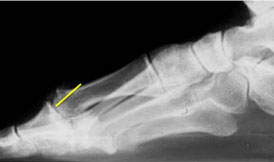First MTP joint cheilectomy

What is a cheilectomy?
For the more minor type of hallux rigidus (big toe arthritis), shaving of the bump of the bone on top of the metatarsal is sufficient, and this is referred to as a cheilectomy.
Type of procedure
This is a day case procedure and same day discharge is usual.
Type of anaesthesia
The operation will be undertaken under a general anaesthetic supplemented with an injection around the ankle to numb the foot (nerve block). The effect of this block will last for a few hours after surgery.
How long will the surgery take?
The surgery normally takes approximately 15 minutes.
Risks of surgery:
Any orthopaedic surgery carries some inherent risks and it is the surgeons responsibility to fully inform you regarding the benefits and risks of this procedure. Mr Shariff will go through this in detail with you to help you make an informed decision. This is a fairly routine procedure with risk of:
-
Infection
If this occurs it is usually a superficial infection around the wound site. It settles with a course of oral antibiotics. Deep infection is extremely rare. Overall risk is 1%. -
Pins & needles or patch of numbness:
Small nerve branches which supply sensation to the skin may be bruised or cut when the skin incision is made. This may cause pins and needles or a patch of numbness around the scar. This feeling generally resolves within a few weeks to a couple of months. Overall risk is 5%.
Recovery from surgery
What can I expect immediately after the surgery whilst in hospital?
When you wake up, it is normal to have numbness in the operated foot as the anaesthetic block will take a few hours to wear off. You will have a bulky dressing to your foot. A stiff sole shoe will be provided in which you can walk after surgery. The physiotherapists will make sure that you are safe on your feet before discharge. You will also be given painkillers to take home. It is normal to experience moderate pain after surgery and you can keep this to a minimum by taking regular painkillers.
Specific recovery protocol:
Day 1 - 7
- Ensure that you keep your foot elevated on pillows to help reduce swelling.
- Foot wrapped in bulky bandage and surgical stiff sole shoe
- Allowed to walk in a stiff sole shoe
- Ice, elevate, take pain medication
- Expect numbness in foot 12-24 hours then moderate pain
- Bloody drainage through bandage expected.
- Do not change bandage.
Day 14
- You will have a follow up visit in clinic.
- You will have an Xray on arrival prior to seeing Mr Shariff
- Your wound will be inspected. You will have absorbable sutures so they will not need to be removed.
- Physiotherapy to encourage movement of the big toe and prevent stiffness will be commenced
- Commence normal footwear once wound is healed.
12 weeks
- You can expect swelling to last for about 4 months, but you will notice that it gradually starts to settle
Post operative clinic visit schedule
- 2 weeks after surgery - wound check and X-ray
- 3 months after surgery - Final follow up clinical exam and discharge
When can I begin to walk?
You are allowed to walk in a stiff sole surgical shoe on the day of surgery. However you must ensure that you use this shoe at all times for the first 2 weeks after your operation as this provides the necessary support while your bone heals.
- 0 - 2 weeks - stiff sole surgical shoe
- 3 weeks onwards - normal shoe with a robust sole
How do I look after my surgical wound site?
Your wound should be healed 2 weeks after surgery. If you notice any redness around the wound site, get in touch with your consultant as you may have a wound infection. Do not pick on any scabs and allow them to fall off. You will be taught some massage techniques to lighten your scar.
How do I shower or wash?
Do not get your wound wet until it heals completely. You can use a waterproof cover or plastic bag over your foot when you have a shower. Only expose your wound to water after it has healed completely.
When can I get back to driving?
It is the responsibility of the driver to ensure that he/she is in control of the vehicle at all times. As a general rule, you are ready to drive when you are able to perform an emergency braking manoeuver without pain. This usually is 2 weeks after surgery. Click here to read the guidance from the DVLA on driving after surgery.
When can I get back to work?
Returning to work is very much dependent on the specific type of job and individual. As a rule of thumb:
- Office based sedentary work -1 week
- Manual labour - 3 weeks
When can I get back to sport?
It depends on the kind of exercise, but as a general rule of thumb you can get back to sports like golf about 1 month after surgery. For high intensity sport, this may take a couple of months.
